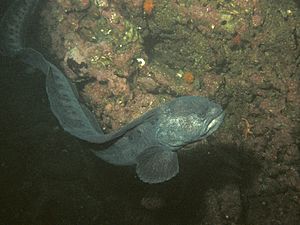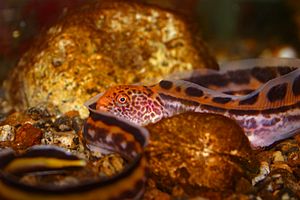Wolf eel facts for kids
Quick facts for kids Wolf eel |
|
|---|---|
 |
|
| Wolf eel in Puget Sound | |
| Conservation status | |
| Scientific classification | |
| Synonyms | |
|
The wolf eel (Anarrhichthys ocellatus) is a fascinating type of ray-finned fish found in the North Pacific Ocean. Even though it's called a "wolf eel" and looks a bit like an eel, it's actually not a true eel at all! It belongs to a family of fish called wolf fishes. This amazing creature is the only species in its special group, or monotypic genus, called Anarrhichthys.
Contents
About the Wolf Eel's Name
The wolf eel was first officially described in 1855 by an American doctor and fish expert named William Orville Ayres. He found it near San Francisco Bay in California. He also created the unique group name Anarrhichthys for this fish.
Why is it Called Anarrhichthys?
The name Anarrhichthys comes from two parts. The first part, Anarhichas, is the name of another type of wolf fish. The wolf eel has a head shape similar to these wolf fishes. The second part, ichthys, simply means "fish."
Meaning of Ocellatus
The second part of its scientific name, ocellatus, means "having eye-like spots." This is because the wolf eel has cool, eye-shaped spots, also called ocelli, on its back fin and body.
What Does a Wolf Eel Look Like?
Wolf eels are different from true eels because they have paired gill slits and pectoral fins (fins on their sides). They can grow quite large, up to about 2.4 meters (8 feet) long and weigh around 18.4 kilograms (40 pounds).
Young wolf eels are bright orange with big dark spots towards their tail. As they get older, their color changes to grey, brownish-grey, or dark olive.
These fish have very strong jaws. They use powerful canine teeth at the front of their mouth and molars at the back to crush their prey. They have one long dorsal fin (back fin) that runs from their head all the way to their tail. They don't have pelvic fins (fins on their belly) or a lateral line (a sensory organ found in most fish).
Male wolf eels have bigger lips and a bump on the top of their head. Wolf eels can live for about 20 years.
Wolf Eel Life Cycle and Reproduction
Wolf eels are known to be very loyal partners. They often mate for life and share the same cave home. They start having babies when they are about seven years old, usually from October until the end of winter.
When they reproduce, the male wraps around the female, and she lays up to 10,000 eggs at once. The male then fertilizes these eggs. After that, both parents coil around the eggs, shaping them into a neat ball about the size of a grapefruit. The male adds an extra layer of protection by coiling around the female.
Both parents take turns guarding their eggs, with only one leaving the cave at a time to find food. The eggs hatch after about 91 to 112 days. During this time, the female gently massages and rotates the eggs. This helps water flow around them, making sure the developing babies get enough oxygen.
Where Do Wolf Eels Live and What Do They Do?
Habitat and Distribution
Wolf eels can be found in caves, cracks, and rocky reefs. They live in both shallow waters and deeper areas, down to about 226 meters (740 feet). Their home range stretches from the Sea of Japan and the Bering Sea all the way down to Northern California.
Behavior
Older wolf eels are usually curious and not aggressive towards humans. However, they can give a painful bite if they feel threatened. As mentioned, male and female wolf eels often stay together for life in their shared cave, taking turns to guard their eggs.
What Do Wolf Eels Eat?
These fish love to eat invertebrates that have hard shells. Their diet includes crustaceans like crabs, sea urchins, mussels, and clams. They use their strong jaws to crush these hard-shelled foods. They also eat some smaller fish. In aquariums, they sometimes prefer softer foods like squid, which is easier on their back teeth.
Who Eats Wolf Eels?
Adult wolf eels have a few predators, including sharks, other large fish, and harbor seals. However, their eggs and young wolf eels are much smaller and don't have strong jaws yet. This means many more species can threaten them, such as rockfish and kelp greenling.
Wolf Eels as Food
The wolf eel has tasty, sweet, and savory white meat. Some Native American tribes along the northwest coast used to call the wolf eel the sacred "doctorfish." Only the tribal healers were allowed to eat this fish, as they believed it would make their healing powers stronger.
Images for kids
See also
 In Spanish: Anguila Lobo para niños
In Spanish: Anguila Lobo para niños









